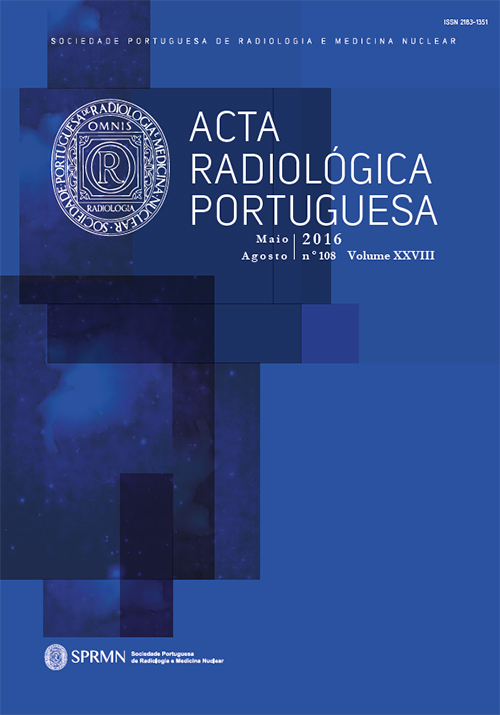MAGNETIC RESONANCE IMAGING (MRI) SPECTRUM OF Rotator Cuff Tears, with Arthroscopic – MRI Contextualizations
DOI:
https://doi.org/10.25748/arp.11986Resumo
Our understanding of rotator cuff (RC) pathogenesis and the optimal management of RC pathology is evolving and shoulder magnetic imaging (MRI) has a crucial role in this development, as it functionally depicts pathology in the painful shoulder patient, conveys optimal sensitivity and specificity rates in rotator cuff tear evaluation and characterization, and allows useful additional information in terms of patient management, namely regarding muscle atrophy, reducing unnecessary arthroscopic procedures.We present and discuss the shoulder MRI protocol used at our Institution, and summarize the imaging spectrum of RC pathology by this technique, using a series of patients evaluated by our Department to conclude that MRI has very high levels of sensitivity and specificity transversely seen is most high work volume Radiology Departments.
Referências
Petchprapa CN, Beltran LS, Jazrawi LM, et al. The rotator interval: a review of anatomy, function, and normal and abnormal MRI appearance. AJR Am J Roentgenol. 2010;195:567-76.
Brox JI. Regional musculoskeletal conditions: Shoulder pain. Best Pract Res Cn Rheumatol. 2003;17:33-56.
Lenza M, Buchbinder R, Takwoingi Y, Johnston RV, Hanchard NC, Faloppa F. Magnetic resonance imaging, magnetic resonance arthrography and ultrasonography for assessing rotator cuff tears in people with shoulder pain for whom surgery is being considered. Cochrane Database Syst Rev. 2013 Sep;24:9.
Ehab A, Abd-ElGawad, Mohammed A. Ibraheem, Ezzat H. Fouly. Evaluation of supraspinatus muscle tears by ultrasonography and magnetic resonance imaging in comparison with surgical findings. Egyptian Journal of Radiology and Nuclear Medicine. 2013;12.
Hashimoto T, Nobuhara K, Hamada T. Pathologic evidence of degeneration as a primary cause of rotator cuff tear. Clin Orthop Relat Res. 2003;415:111–20.
Khan KM, Cook JL, Bonar F, Harcourt P, Åström M. Histopathology of common tendinopathies. Update and implications for clinical management. Sports Med.1999;27:393-408.
Hegedus EJ, Goode A, Campbell S, et al. Physical examination tests of the shoulder: A systematic review with meta-analysis of individual tests. Br J Sports Med. 2008;42:80-92.
Beaudreuil J, Nizard R, Thomas T, et al. Contribution of clinical tests to the diagnosis of rotator cuff disease: A systematic literature review. Joint Bone Spine. 2009;76:15-19.
de Jesus JO, Parker L, Frangos AJ, Nazarian LN. Accuracy of MRI, MR arthrography, and ultrasound in the diagnosis of rotator cuff tears: a meta-analysis. AJR Am J Roentgenol. 2009;192:1701-7.
Sher JS, Iannotti JP, Williams GR et al. The effect of shoulder magnetic resonance imaging on clinical decision making. J Shoulder Elbow Surg 1998;7(3):205-9.
Spencer EE, Jr., Dunn WR, Wright RW, et al. Interobserver agreement in the classification of rotator cuff tears using magnetic resonance imaging. Am J Sports Med. 2008;36:99-103.
Liem D, Lichtenberg S, Magosch P, Habermeyer P. Magnetic resonance imaging of arthroscopic supraspinatus tendon repair. J Bone Joint Surg Am. 2007;89:1770-6.
Lohr JF, Uhthoff HK. The microvascular pattern of the supraspinatus tendon. Clin Orthop Relat Res. 1990;35-8.
Strauss EJ, Salata MJ, Kercher J, Barker JU, McGill K, Bach BR Jr, Romeo AA, Verma NN. The arthroscopic management of partial-thickness rotator cuff tears: a systematic review of the literature. Arthroscopy. 2011 Apr;27(4):568-80.
Vinson EN, Helms CA, Higgins LD. Rim-rent tear of the rotator cuff: A common and easily overlooked partial tear. AJR Am J Roentgenol. 2007;189:943-6.
Farley TE, Neumann CH, Steinbach LS, et al. Full-thickness tears of the rotator cuff of the shoulder: Diagnosis with MR imaging. AJR Am J Roentgenol. 1992;158:347-51.
Thomazeau H, Boukobza E, Morcet N, Chaperon J, Langlais F. Prediction of rotator cuff repair results by magnetic resonance imaging. Clin Orthop Relat Res 1997;344:275-83.
Ciepiela MD, Burkhead WZ. Classification of rotator cuff tears. In: Burkhead WZ Jr., ed. Rotator cuff disorders. Baltimore: William and Wilkins, 1996:100-10.
Agrawal V. Healing rates for challenging rotator cuff tears utilizing an acellular human dermal reinforcement graft. International Journal of Shoulder Surgery. 2012;6(2):36-44.
Zlatkin MB, Reicher MA, Kellerhouse LE, McDade W, Vetter L, Resnick D. The painful shoulder: MR imaging of the glenohumeral joint. J Comput Assist Tomogr. 1988.
Sein ML, Walton J, Linklater J, et al. Reliability of MRI assessment of supraspinatus tendinopathy. British Journal of Sports Medicine. 2007;41(8):e1-e4.
Goutallier D, Postel JM, Gleyze P, Leguilloux P, Van Driessche S. Influence of cuff muscle fatty degeneration on anatomic and functional outcomes after simple suture of full-thickness tears. J Shoulder Elbow Surg 2003;12(6):550-4.
Buck FM, Grehn H, Hilbe M, et al. Magnetic resonance histologic correlation in rotator cuff tendons. J Magn Reson Imaging. 2010;32:165-72.
Downloads
Publicado
Edição
Secção
Licença
CC BY-NC 4.0


